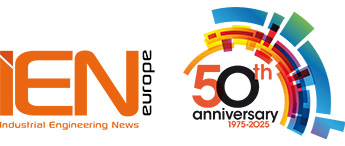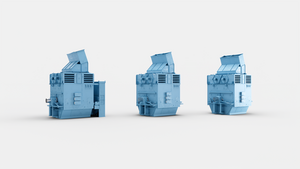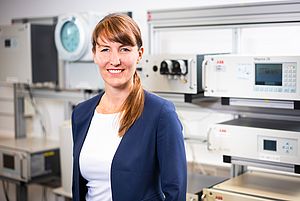In September 2023, the International Energy Agency (IEA) published its updated Net Zero Roadmap with the conclusion that limiting global warming to 1.5 °C by 2030 is very challenging. But the pathway does remain open. Encouragingly, there are technologies already available today, such as energy efficiency and increased electrification that can deliver more than 80% of the emissions reductions needed.
There is huge potential for electric motors to boost energy efficiency, since motor-driven systems such as pumps and fans, and a wide variety of other applications, represent 65% of industrial electricity use. And by 2040 the number of motors will double. There are more than 300 million electric motor-driven systems currently in operation. It is estimated that if they were replaced with optimized, high-efficiency equipment, global electricity consumption could be reduced by up to 10% – equivalent to more than the annual power consumption of Poland.
Currently, the global installed base mainly uses older, very low efficiency motors – some still at IE1 or IE2 levels. However, the latest Ecodesign regulation that came into force in 2023 requires motors between 75 kW and 200 kW to meet the IE4 level. Where Europe has led the way, other regions are also adopting similar legislation.
One of the most significant developments in motor technology is the synchronous reluctance (SynRM) design. This works as a package with a variable speed drive (VSD) to offer IE5 ultra-premium efficiency. It can be used as a drop-in replacement for standard IE3 induction motors, where they reduce energy losses in the motor by up to 40%, with significantly lower energy consumption and CO2 emissions.
Most recently, ABB took the next step by becoming the first manufacturer to offer the anticipated IE6 efficiency level in a magnet-free SynRM design. Early adopters of IE6 hyper-efficiency motors will reap the benefits of reduced energy costs and increased productivity while moving ahead of current sustainability targets.
More efficient motors for optimized TCO
While operators might be reluctant to adopt the latest technology due to the upfront investment, the motor only costs a fraction of
the energy used to run it over a typical 15year lifetime. That is why it is vital to look at the motor’s total cost of ownership (TCO). For an IE5 SynRM, the upfront cost is just 2% of its TCO, while maintenance accounts for 1% and the remaining 97% is spent on electricity.
A more efficient motor will soon pay for itself, sometimes in only a few months when energy prices are high. It will then go on to generate annual savings for the rest of its working life.
Furthermore, saving energy has a dual benefit in helping existing generation capacity to go further while also reducing carbon emissions – when the motor uses power generated from non-renewable sources.
Reliability and durability are crucial
While energy efficiency is an increasingly critical factor when specifying a motor, it is just one aspect of its performance that must also include power, reliability and durability. A motor cannot deliver its promised TCO if it does not provide continuous reliable operation with no risk of costly downtime. This is where ABB has an advantage, since we draw on over 140 years of domain expertise in building our portfolio of premium high-performance motors, with models tailored to meet the unique needs of every industrial application.
The SynRM design offers up to 30°C lower winding temperatures and up to 15°C lower bearing temperatures. These increase reliability, prolong the motor lifetime, and reduce the need for maintenance. Lower bearing temperatures are known as an important factor in reducing life-cycle costs because bearing failures cause about 70% of unplanned motor outages.
Liquid-cooled motors for quieter control and efficiency
For many applications, liquid-cooled motors provide quieter, more efficient operation. To meet this need, ABB has developed the world’s first complete range of IE5 SynRM Liquid-cooled motors from 75 kW to 710 kW. The addition of liquid cooling results in high power density without an increase in size. That makes the new motors equally efficient at saving energy and cutting emissions in new projects as they are in drop-in replacements for less efficient motors.
Liquid-cooled SynRM technology is especially important in the food and beverage industry, where changeable loads and speeds are a challenge for processes like chocolate production. An early adopter was SACMI Packaging & Chocolate in Italy that focuses its operations on guaranteeing the optimal energy consumption for its machinery and full line customers. The company has installed IE5 SynRM Liquid-cooled motors to reach a 3-4% energy saving in the chocolate conching machines. In combination with a VSD, the SynRM motor has been able to reach twice the nominal speed, pairing energy and production efficiency.
Increased Safety motors for explosive atmospheres
Potentially explosive atmospheres are found in industries such as chemicals, food and beverage, oil and gas, pulp and paper, and pharmaceuticals. While safety is paramount, there is a growing emphasis on improving efficiency in these very energy intensive industries - chemical processing is the second largest industrial energy consumer. The new IE5 SynRM Increased Safety motors are certified to ATEX and IECEx requirements and certified for use with drives.
In addition to providing all the proven benefits of SynRM technology, such as IE5 ultra-premium efficiency, higher reliability and reduced maintenance, the new motors can help customers achieve a more cost-effective installation. For example, in Zone 1, the cooler running design could allow the use of the new motor where a flameproof motor with a special enclosure would be the traditional choice. While in Zone 2, the improved loadability of SynRM motors is important. This could allow a smaller, and therefore lower-cost, motor to fulfill the same duty.
Giving machine builders a new competitive edge
In the competitive machine-building space, OEMs must continually improve their offering amid tight cost constraints. Success depends on understanding the issues end users face and adopting appropriate technologies to overcome them. These applications demand highly reliable, powerful motors with long life and low maintenance.
The solution is to use specialized high power density (HDP) motors that offer even greater power density than traditional AC motors to enable a more compact installation footprint. Modern HDP motors are designed for use with a variable speed drive (VSD). This combination delivers high energy efficiency and superior machine performance in several applications, including extrusion, injection molding, lifting, conveyors, winders, machine tools, and test benches – among many others.
HDP motors also have advantages in terms of their low rotor inertia, high overload capacity, and outstanding dynamic response. Low rotor inertia enables faster reversion of the motor’s rotational direction, which speeds up the machine’s back-and-forth motion. This is a critical factor for safe and smooth maneuvering or machine control.
There are two ways in which machine builders can adopt them to gain a new competitive edge. First, they can retrofit an existing machine with a stronger drop-in replacement motor to boost machine performance. Second, machine builders can select a motor that has a smaller frame size but the same output when designing a new machine type. This is important as floor-space constraints are making machine compactness an increasingly significant differentiator for machine builders and their customers.
Circularity by design
The premium motors portfolio is supported by ABB’s 2030 sustainability strategy that aims to have 80% of our products and solutions covered by a circularity approach and to send zero waste from our operations to landfill. Our framework promotes circular practices throughout our supply chain and product life cycles to achieve this. One example is our collaboration with partners to create a more sustainable low voltage motor. Using sustainable alternatives from cradle to gate, the CO2 footprint of an IE5 SynRM motor has been reduced by 20%. Among the key design innovations are: a stator housing cast from 100% recycled aluminum, supplied by Stena Aluminium; and prototype low-carbon bearings, developed in collaboration with SKF, with a 70% lower CO2 footprint than standard bearings.
Energy efficiency is set to play a vital role in keeping industry on track to help the world meet its carbon reduction targets. This is where energy efficient motors can help operators to cut their electricity usage but with no impact on their bottom-line.
Author: David Hawley, Global Head of Sales, IEC Low Voltage Motors, ABB































